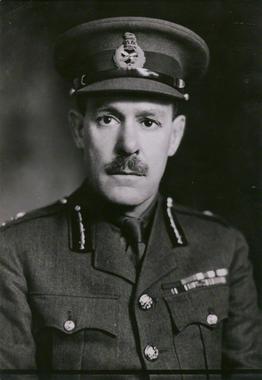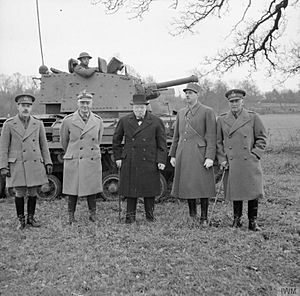Giffard Le Quesne Martel facts for kids
Quick facts for kids
Lieutenant-General Sir
Giffard Le Quesne Martel
|
|
|---|---|

Martel in 1942.
|
|
| Born | 10 October 1889 Millbrook, Southampton, Hampshire, England |
| Died | 3 September 1958 (aged 68) Camberley, Surrey, England |
| Allegiance | |
| Service/ |
|
| Years of service | 1908–1945 |
| Rank | Lieutenant-General |
| Service number | 6628 |
| Unit | Royal Engineers Royal Tank Regiment |
| Commands held | 50th (Northumbrian) Infantry Division Royal Armoured Corps |
| Battles/wars | First World War Second World War |
| Awards | Knight Commander of the Order of the Bath Knight Commander of the Order of the British Empire Distinguished Service Order Military Cross |
Lieutenant-General Sir Giffard Le Quesne Martel (born October 10, 1889 – died September 3, 1958) was a very important British Army officer. He fought in both the First World War and the Second World War. People often called him "Q Martel" or just "Q". He was a brilliant engineer and helped create new ways to use tanks in battle.
Contents
Early Life and Military Start
Martel came from a family of soldiers. His father, Brigadier-General Sir Charles Philip Martel, was in charge of ordnance factories. Giffard Martel married Maud Mackenzie in 1922. They had two children, a son named Peter and a daughter named Gillian.
In 1908, Martel joined the Royal Military Academy, Woolwich. He became a second lieutenant in the British Army's Royal Engineers in 1909. Martel also helped start The Royal Navy and Army Boxing Association in 1911. He was even the Army and Inter Services boxing champion before and after the First World War.
Tanks in the First World War
In 1916, Martel was an engineer officer. He had seen the first British tanks used in the Battle of the Somme. Because of this experience, he was put in charge of a special training ground.
At Elveden, Norfolk, he created a copy of the British and German trench systems. This included the "no man's land" in between. Here, soldiers could practice using tanks.
Developing Tank Ideas
Martel became very interested in tanks. He believed they were the future of fighting. In November 1916, he wrote a paper called A Tank Army. In it, he suggested an army made only of armoured vehicles.
His ideas greatly influenced another officer, J. F. C. Fuller. At first, Fuller thought tanks were just a small help to infantry. But Martel's paper changed his mind. Martel also studied how to build special wire roads to help tanks move across difficult ground.
In late 1916, Martel worked with Hugh Elles and Fuller in France. He helped plan the tank tactics used in the Battle of Cambrai. During the war, Martel was recognized five times for his bravery and good work.
Between the World Wars
After the war, in 1919, Martel was a Major. He combined his love for tanks and military bridges. He became the head of the Experimental Bridging Establishment in Christchurch. This place studied how tanks could be used for engineering tasks. These tasks included building bridges and clearing mines.
Martel's Bridge Designs
He worked on special Mark V tanks. These tanks could carry and put down a bridge designed by Major Charles Inglis. This "Canal Lock Bridge" was long enough to cross a canal lock. Martel used the tank's engine power to move the bridge into place. For clearing mines, tanks were fitted with heavy rollers.
Martel also created his own bridge design, the "Martel bridge." It was a modular bridge, meaning it was made of many parts that fit together. This made it easy for the military to use. The British Army adopted it in 1925 as the "Large Box Girder Bridge."
A smaller version, the "Small Box Girder Bridge," was adopted in 1932. Many other countries copied this design, including Germany and the United States. The modular idea from Martel's bridge was also used for the famous Bailey bridge. Later, Martel received money because his design had influenced the Bailey bridge.
Creating the Tankette
Martel also kept working on tanks by himself. In 1925, he built a small, one-person tank in his own garage. It was called a "tankette." It used a car engine and could go 15 miles per hour.
He showed it to the War Office, which is like the army's headquarters. They ordered four test models. Another company, Carden Loyd, also built a similar one-person tankette.
In 1927, more Martel tankettes were ordered. The army wanted to see if they could be used for scouting ahead. They were tested alongside two-person tankettes. However, the idea of a one-person fighting vehicle was soon dropped. It was too hard for one person to drive and fire a weapon at the same time.
Later Career Before WWII
In 1928, Martel became part of the Mechanical Warfare Board. This group worked with industries to advise on new military vehicles. From 1930 to 1934, Martel served as an instructor at the British Indian Army's Command and Staff College in Quetta.
From 1936 to 1939, Martel worked at the War Office. He helped with the army's mechanization, which meant adding more machines and vehicles. In 1936, he saw a large tank exercise in the Soviet Union.
Second World War Service
Before the Second World War began, Martel was put in charge of the 50th (Northumbrian) Infantry Division in February 1939. This division was made "motorised," meaning all its infantry could be carried by lorries.
Battle of Arras
When the war started, Martel's division went to France. On May 21, 1940, during the Battle of France, Martel led a tank attack. They attacked Generalmajor Erwin Rommel's 7th Panzer Division in the Battle of Arras.
Martel's attack pushed the German front line back eight miles. Even though they couldn't hold the ground, this attack forced the Germans to stop and regroup. This gave the British Army time to escape from Dunkirk.
Leading the Royal Armoured Corps
After the British forces left France, Martel became the Commander of the Royal Armoured Corps in 1940. Here, he used his ideas about armoured warfare to train and organize tank units. In 1941, he shared his experiences and thoughts on German tank tactics with the United States.

Martel was promoted to Lieutenant-General in 1942. Later that year, he moved to postings in Burma and India.
Mission to the Soviet Union
In March 1943, Martel became the head of the British Military Mission to the Soviet Union. He visited the front lines in the Kursk-Oryol region. He studied how the Soviet army fought and used its tanks.
Martel wrote in his autobiography that he advised the Soviet High Command to let the Germans attack first at the Battle of Kursk. This was a very important battle. While others had similar ideas, Martel's advice on how to stop an enemy breakthrough may have been helpful.
His reports about the Soviet army were praised by his superiors. He noted that the Soviet experience in battle would be very useful for the upcoming invasion of Normandy. However, his relationship with the Soviets became difficult after a new, anti-communist Air Marshal arrived. Martel was called back to Britain in February 1944. Soon after, he lost his right eye in a German bombing raid on London.
Later Life and Retirement
Martel was knighted in 1943, which means he received the title "Sir." He retired from the Army in 1945 as a Lieutenant-General. He tried to become a Member of Parliament for the Conservative Party in the 1945 UK General Election, but he did not win.
After retiring, Martel wrote books and articles about military topics. He passed away at his home in Camberley, Surrey, on September 3, 1958.

